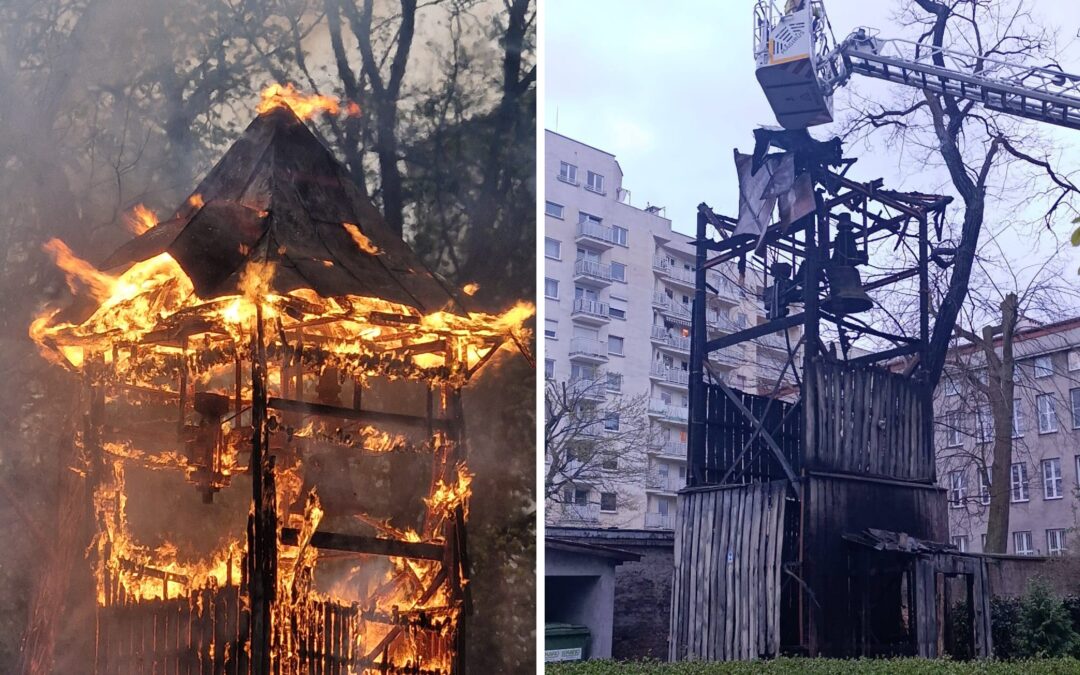Keep our news free from ads and paywalls by making a donation to support our work!

Notes from Poland is run by a small editorial team and is published by an independent, non-profit foundation that is funded through donations from our readers. We cannot do what we do without your support.
A 200-year-old church belfry – the oldest wooden structure in Warsaw’s Praga district on the eastern bank of the Vistula River – has burned down.
Built in 1817, it housed two bells, including one from 1772, both of which survived the fire thanks to a steel reinforcement structure surrounding them. The cause of the fire is yet to be confirmed, but police have detained one person in relation to the incident.
The blaze broke out on Tuesday at around 5:15 p.m. A fire service spokesman, Łukasz Zagdański, told the Polish Press Agency (PAP) that around three quarters of the building, including its entire roof, was destroyed.
A member of the local council, Krzysztof Michalski, wrote that all that was left of the historic bell tower was the steel frame holding the bells and a few shuttering boards. “This is a huge loss for the monuments of the right [eastern] bank [of the Vistula],” he added, quoted by PAP.
The cause of the fire is as yet unknown and the matter is being investigated by the police. According to the firefighters who were present at the site, some evidence suggests arson, writes the Gazeta Wyborcza daily.
On Wednesday, a police spokeswoman, Joanna Węgrzyniak, confirmed media reports that a man has been detained based on witness accounts and evidence collected at the scene. He was under the influence of alcohol at the time of his detention, she told Polskie Radio.
Two more weeks to save @notesfrompoland!
We're halfway through our campaign and we've received 300 donations from our readers. Thank you for the generous support!
But to continue our work we still need your help. Click below to learn more https://t.co/0gVkMlaA0W
— Notes from Poland 🇵🇱 (@notesfrompoland) April 15, 2025
Local conservation authorities and the church to which the belfry belonged have already mentioned the idea of reconstructing the destroyed building.
The regional conservator of historical monuments, Marcin Dawidowicz, said that previously prepared technical documentation would make this possible.
Michał Laszczkowski, former director of the National Institute for Historic Preservation (NIKZ), recalled that, two years ago, a technical design for the renovation of the bell tower was prepared.
“It was supposed to be used for its renovation. It may now serve for reconstruction,” he told Gazeta Wyborcza.
One of Warsaw’s most unusual neighbourhoods – a small, green enclave of wooden Finnish houses erected in the wake of WW2 – once again finds its future in the balance, with activists warning that the city wants to squeeze out residents and gentrify the area https://t.co/Zo5bTMosgY
— Notes from Poland 🇵🇱 (@notesfrompoland) April 8, 2024
The bell tower was the last surviving element of a wooden church that stood in what was once the village of Kamion but has long since been absorbed into Warsaw.
It was entered in the register of historical monuments in 1979 as part of the complex of the Church of Our Lady of Victory that now exists at the site. That brick church was built in 1929-1931 as a commemoration of Poland’s victory in the 1920 Battle of Warsaw during the Polish-Soviet war.
The cemetery surrounding the temple is considered to be the oldest preserved necropolis within the boundaries of present-day Warsaw. It existed as early as the beginning of the 14th century, with the participants in a battle against Sweden in 1656 being buried there, among others.
This week marks the centenary of the Battle of Warsaw, at which Poland inflicted a decisive defeat on the Soviet Red Army and changed the course of European history.
Norman Davies explains the battle's causes, course and consequences https://t.co/NGUvgxOkKG
— Notes from Poland 🇵🇱 (@notesfrompoland) August 12, 2020

Notes from Poland is run by a small editorial team and published by an independent, non-profit foundation that is funded through donations from our readers. We cannot do what we do without your support.
Main image credit: Mazowiecki Wojewódzki Konserwator Zabytków/Facebook

Agata Pyka is a former assistant editor at Notes from Poland. She specialises in Central and Eastern European affairs, cybersecurity, and investigative reporting. She holds a master’s degree in political communication from the University of Amsterdam, and her work has appeared in Euractiv, the Balkan Investigative Reporting Network (BIRN), and The European Correspondent, among others.



















